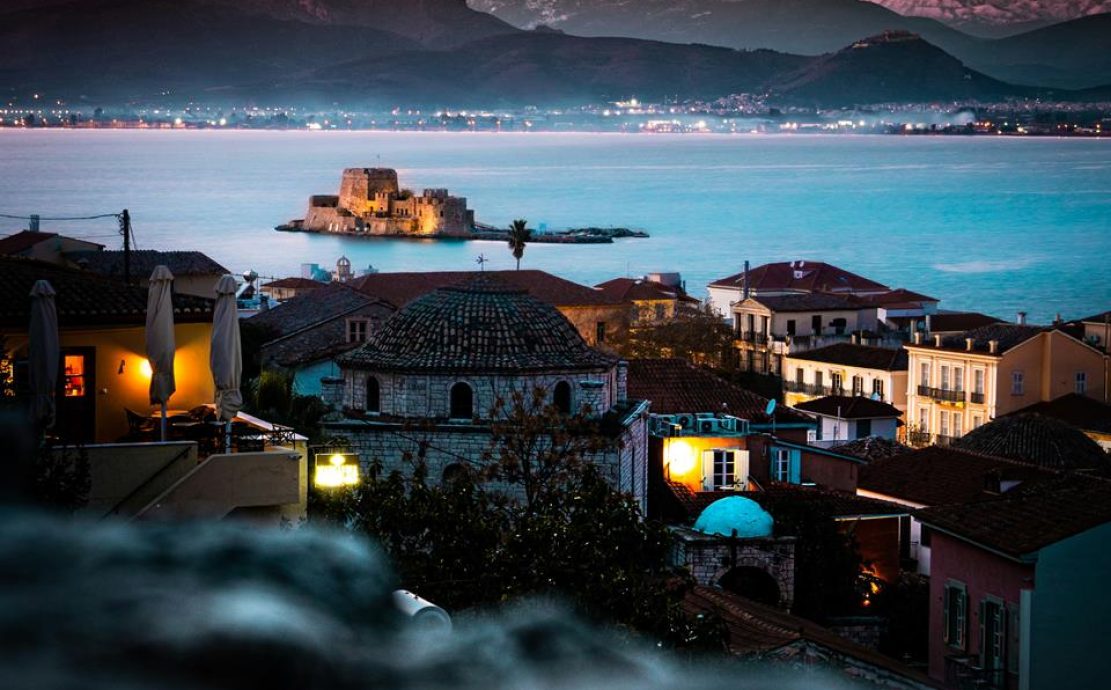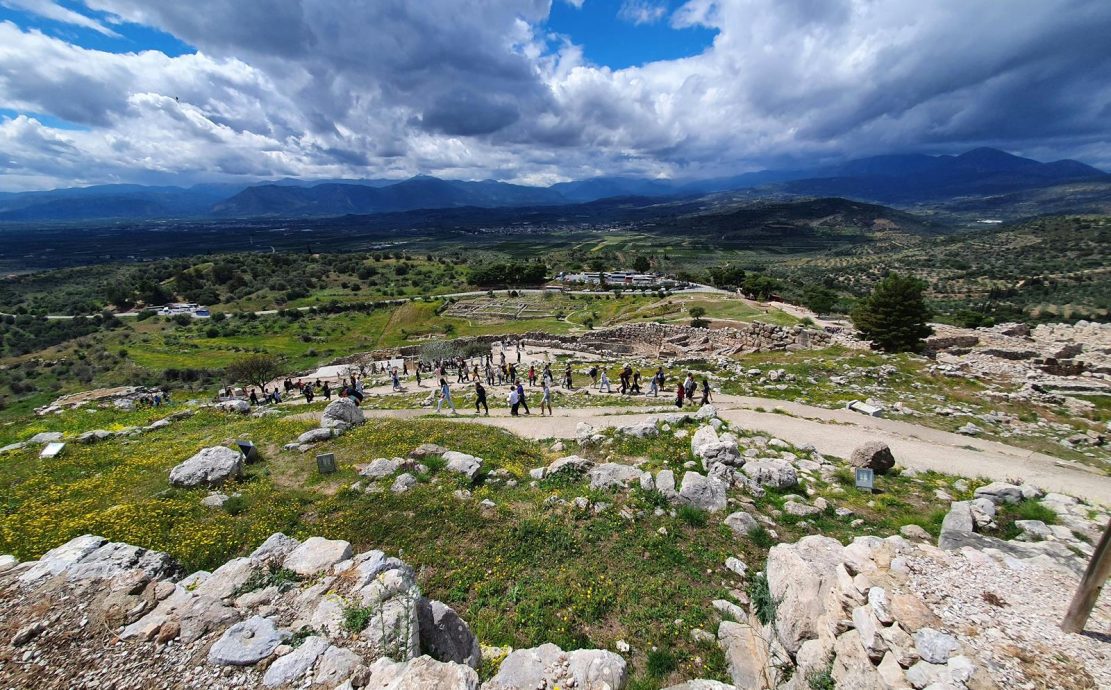Nafplio
Echoes of History, Whispers of Beauty

The first capital of Greece
During ancient times Nafplio was at the shadow of Argos and it was mainly used as a port since the 7th century B.C. Since then, Nafplio was besieged and occupied by several conquerors and was under the occupation of Frankish, Venetian and Ottoman rule, while it reclaimed its freedom for a small period of time during the second Venetian Domination. During the first Venetian Domination great historical monuments were built, such as the Castle of Toron and Bourtzi. Bourtzi or “Kasteli” according to the Venetians is a small islet right in front of Nafplio’s port.
Must Visit
Bourtzi, the fort on the sea, which is still known by its Turkish name meaning tower, is the trademark of the town. Today, there are special boats at the seafront that can take you there for a short visit.
The Palamidi fortress is one of the greatest achievements of the Venetian fortification architecture. There is a total number of eight bastions of which the central one, Agios Andreas, was the main headquarters of the fort. A later use of some of the bastions was that of a gloomy prison. The Palamidi is accessible either by the road which ends at its eastern gate or by the famous steps which are located at its western side, in the east of the Grimani Bastion. According to the legend these steps number 999, but in reality they are fewer. However, if you decide to ascend them, the view from the top will compensate you.
Nowadays known as Vasileos Konstandinou Street, the “Megalos Dromos” was the most important road in the town in the 19th century, that’s why it was called “megalos” meaning great. The Great Road, as well as its parallel Staikopoulou Street constitute an important passage for both locals and visitors. Apart from the various shops along these roads, one can sit at one of the beautiful refreshment stands in the “Great Road” or have lunch or dinner in one of the taverns in Staikopoulou Street.
The rocky peninsula of Acronafplia was the walled town of Nafplion from antiquity to the end of the 15th century. Built at the foot of the Palamidi, it was connected to it through a secret passage. Nowadays, only a few buildings, such as the ruins of the Greek castle of the ancient acropolis and the subsequent Roman and Byzantine additions, are saved.
PSAROMACHALAS
The so called Psaromachalas, meaning the fishermen’s neighborhood, is one of the oldest and most picturesque neighborhoods in the town and extends to the foot of the northwest Acronafplia, above Staikopoulou Street. Nowadays, it is still considered one of the most picturesque spots of the Old Town of Nafplion.
Trion Navarchon Square (The Square of the three admirals) is dedicated to the memory of the three admirals, Kordington of England, Derigny of France and Hayden of Russia, who fought the Turkish-Egyptian fleet in the naval battle of Navarone on 8th October 1827. There are remarkable neoclassical buildings in the square, among which the building that houses the Town Hall.
This exceptional sculpture is located between the church of Agii Pades and today’s cemetery of the town in Michail Iatrou Street. The area in front of the Lion of Bavaria is a small park with benches where you can have a rest during your tour of the town.
The Land Gate, built in 1708, comprised the only entrance to the town by land, which would be closed at sunset. Today, the façade of the gate has been reconstructed. Generally, its structure is simple: an arch with two pillars on either side. At the top of the gate there was a statue of a lion, the symbol of the Venetian Republic.
Museums
The Archaeological Museum is housed in an imposing stone Venetian building on the west side of Syndagma Square. The permanent exhibition includes findings from various periods found in the surrounding areas.
The War Museum is housed in a two-storey building at 22 Amalias Str. which once was the first Army Cadet School built by I. Kapodistrias.
The Peloponnesian Folklore Foundation “Vasilios Papantoniou” was established in 1974. Its primary aim is the research, study, conservation and demonstration of Modern Greek culture.
The Museum of Childhood “Stathmos”, the first museum for children, was founded in 1989 by the Peloponnesian Folklore Foundation in cooperation with the Local Authority. It is located in the old warehouse of the old railway station.
The Komboloi Museum (komboloi=chaplet or string of beads), the first and unique in the world, was established by Mr. and Mrs. Evaggelinos in April 1998. It is accommodated in a privately-owned two-storey building at 25 Staikopoulou Str. in the old town of Nafplion. It hosts a unique collection of almost 1000 strings of beads dated from 1700 to 1950.
In 1869 I. Karonis establishes his distillery house driven by his love for ouzo production. Today, in the distillery museum you can see tools, machinery and filed documents of the distillery house which date back to the 1880’s. The recipe of the optimum quality Karonis ouzo remains unchangeable until the present day.
The Automotive Museum Nafplias, a non profitable organization, is the desired result of passionate collectors and a dream that came true through a collective effort. The cars on display are of either Greek or foreign manufacturing origin. It is noted that the museum opens on request.
Tel. 27520-47232
Mobile phone: 6932681166
Email: info@automuseum.gr
The Ecclesiastical Museum is located in the south side of the Church of Evaggelistria. It houses the collection of ecclesiastical objects such as icons, holy vessels and liturgical books.
Argolida
The Ancient Theatre of Epidaurus is one of the most remarkable monuments of the Greek antiquity. It has always been admired for its beauty, symmetry and excellent acoustics. It also has a seating capacity of 15.000 spectators. It is worth attending a theatrical performance during the summer.
The Small Theatre of Epidaurus is situated in the village of Old Epidaurus. Important musical events take place there every July. Nearby, on the north side of the beach, lies the sunken city. All you need is a mask and a snorkel.
Mycenae, the most important Mycenaean archaeological site, lies in the cove of the plain of Argolis. The Lion Gate, the main entrance to the citadel, the Cyclopean Walls, the Palace as well as important graves and tombs are sights worth visiting.
Ancient Theatre of Argos
The ancient theatre of Argos is a particularly impressive construction with unique architecture, which is distinguished because its seats are carved in natural rock.
Ancient Agora of Argos
In ancient times, it was continually the center of the town with places of political gatherings, galleries, sanctuaries, fountains etc. Today, there is a street market twice a week and it is also used as a parking lot.
Tolo
Tolo has developed into a popular summer resort visited by tourists from all over the world. It is a widely recognisable area due to its sandy beach and the two tiny islands, Koronissi and Romvi, which adorn its bay.
Ancient Assini (Kastraki)
The citadel of Ancient Assini or Kastraki is located next to Tolo. There you can see the traces of a prehistoric settlement, parts of the majestic courtyard of the citadel and Hellenistic towers that maintain their medieval repairs.
The area of Ancient Tiryns, around the 8th km of Argos – Nafplio Road, constitutes an important UNESCO World Heritage Site. It is worth visiting the Western Bastion, the Cyclopean Walls, the Lower Acropolis and the Geometric Church of the archaeological site.
Midea, which is considered the third most important, fortified Mycenaean Acropolis of Argolis, is located in the middle of the distance between Mycenae and Tiryns. Its Acropolis was built on the top of a conical hill, at a strategic location.
The Mycenaean Cemetery of Dendra extends to the southwest slope of a low hill, in the west of the Mycenaean Acropolis of Midea. The excavated part includes 1 vaulted and 16 chambered tombs. The excavation yielded important findings, the most interesting of which is the famous Armor of Dendra.
The Pyramid of Hellenikon is located near the town of Argos, on an ancient road that connected Argos with Tegea. There is still a mystery concerning its use. It is thought to have been a common tomb for soldiers, a small observatory or a tower used to send smoke signals.
The archaeological site of Lerna, located about 10 km far from the village of Myloi, is famous from the Greek mythology because of Hercules’ struggle with the Lernaean Hydra, a mythical creature with 9 heads.
Nafplio
Prefecture of Argolida, Coastal Road of Nea Kios, Tel. 27520-23766
Town Hall, 34 Vas. Konstantinou, Tel. 27520-23332
Tourist Information, 25th Martiou, Tel. 27520-24444
Police Station, 14 Kountouriotou, Tel. 27520-21536
Tourist Police, 14 Kountouriotou, Tel. 27520-28131
Fire Brigade, 25th Martiou, Tel. 27520-27222
Port Authority, 5 Kotsonopoulou, Tel. 27520-27022
Custom House, 85 Bouboulinas, Tel. 27520-27401
Post Office, 1 Sidiras Merarchias, Tel. 27520-24230
Hospital, Kolokotroni & Asklipiou, Tel. 27520-27309
O.T.E. (Telecommunications Org.), 2 Polyzoidou, Tel. 27520-22121
K.T.E.L. (Bus Station), 8 Sygrou, Tel. 27520-27323
O.S.E. (Railway Station), Paraliaki Odos N. Kiou, Tel. 27520-26400
Radio Taxi, 6 Sygrou, Tel. 27520-24120
The Arvanitia Promenade is one of the most popular walks in the town. It starts at the end of the seafront and leads to Arvanitia Square, covering a distance of about 1 kilometer. Below the square there is an organized beach where you can swim, sunbathe or simply relax. If you keep walking from the square to the east, along the foot of the Palamidi, you will reach the beach of Karathona in approximately 2.7 kilometers. If you wish to return to the Old town from the square, head downhill to Staikopoulos Park and the Land Gate.
The Grimani Bastion was built in the north-east corner of the Castello di Toro. Even today it is in good condition and it is visible from the Land Gate and Staikopoulos Park.
It is one of the most important mansions from the reign of Otto in town. The building dates back from the Second Venetian Occupation but it was rebuilt in 1831 when the second floor was added.
The seafront is an ideal place to go for a stroll, especially at sunset, when it becomes a very romantic setting or relax in one of the nice cafeterias there and enjoy the view to the Bourtzi.
1 Arvanitia
Small pebbly beach below the Palamidi, at a short distance from the Old Town. Easily accessible even on foot. Free parking space.
2 Neraki
Tiny pebbly beach located in the middle of the graveled path connecting the beaches of Arvanitia and Karathona. Access on foot or by bicycle. No facilities.
3 Karathona
Long sandy beach with shallow waters, ideal for children and families. Approximately 3 km from Nafplio. Spacious parking lot. Variety of facilities and activities offered. Locals’ favorite.
4 Tolo
Large sandy beach in Tolo, about 10 km from Nafplio. Very well equipped. Suitable for families. Free parking space.
5 Kastraki of Ancient Assini
Small pebbly beach next to the site of Ancient Assini. No facilities. Free parking space.
6 Plaka
Organized large pebbly beach, next to Drepano village. There are crowded cafeterias and beach bars along with isolated spots for those who seek some privacy.
7 Kondyli
Beautiful large beach with clear waters, between Vivari and Candia villages. Accessible by car. Free parking space.
8 Candia
Large pebbly beach, next to the village of Candia, suitable for children and families. There are beach bars, cafés and restaurants.
9 Iria
Large quiet beach, next to the village of Iria. Suitable for children and families. Free parking space along the beach.





